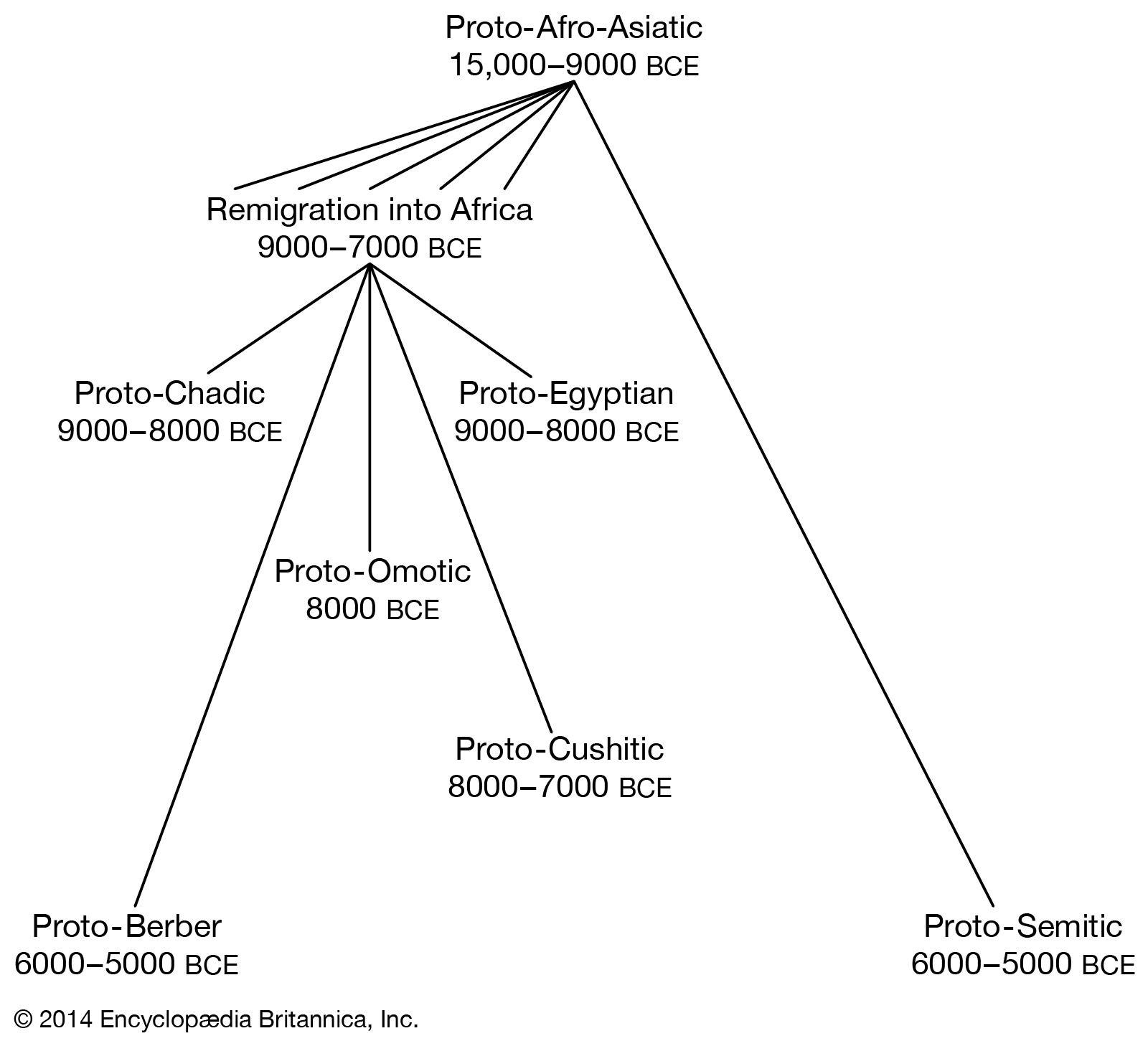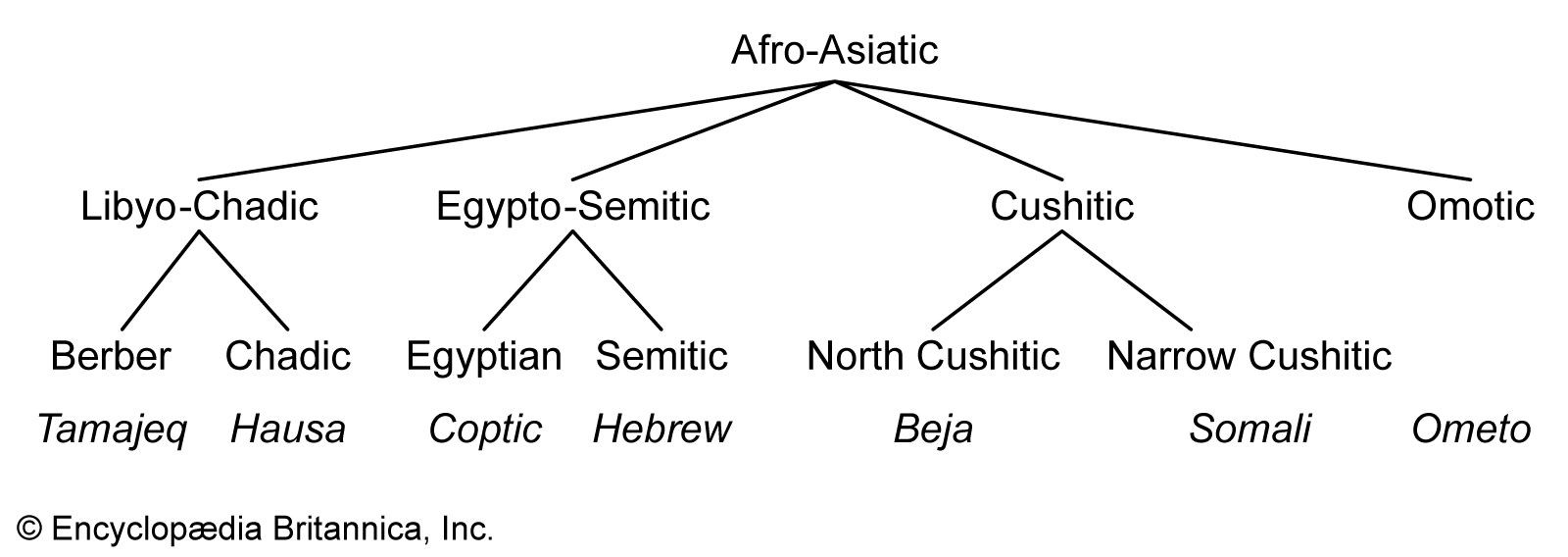The Afro-Asiatic language family represents a major language phylum primarily spoken in Western Asia, North Africa, the Horn of Africa, and parts of the Sahara/Sahel. Understanding its origins and diversification provides crucial insights into human history and linguistic evolution. The quest to uncover the roots of the Afro-Asiatic language family leads us back to the ancient world, exploring theories about its geographical origin and the dispersal of its branches.
Proto-Afro-Asiatic Origins and Homeland
Linguists hypothesize that all modern and extinct Afro-Asiatic languages descend from a common ancestor known as Proto-Afro-Asiatic. This proto-language is estimated to have been spoken during the Mesolithic Period, roughly 15,000 to 10,000 BCE. However, the precise location of the Urheimat, or original homeland, of Proto-Afro-Asiatic speakers remains a subject of scholarly debate.
 Migration patterns of Afro-Asiatic languages from the Middle East Urheimat.
Migration patterns of Afro-Asiatic languages from the Middle East Urheimat.
Early theories, such as that proposed by Igor Diakonoff, suggested a Saharan origin for Afro-Asiatic. This hypothesis posited that the Sahara Desert region was the cradle of the language family, with migrations spreading outwards around 5000 BCE. Diakonoff proposed that the linguistic diversity within Afro-Asiatic arose from extensive language contact and interethnic interactions across this broad area. He even suggested that the Semitic languages, a major branch of Afro-Asiatic, originated from a migration out of Africa.
However, more recent research, particularly influenced by the “Out of Africa” theory of human origins and archaeological evidence related to the development of agriculture around 10,000 BCE, points towards a Middle Eastern Urheimat. The Fertile Crescent, a region known for early agricultural development, has become a prominent candidate. This theory suggests that Proto-Afro-Asiatic speakers originated in the Fertile Crescent and subsequently migrated back into Africa. These migrations likely proceeded through the Sinai Peninsula and the Nile River Valley, eventually leading to the establishment of the five major Afro-Asiatic language branches in Africa: Egyptian (Nile Valley), Amazigh (Berber, North Africa and Sahara), Chadic (Central Africa, Lake Chad basin), Cushitic (Horn of Africa), and Omotic (southwestern Ethiopia). Later migrations from South Arabia introduced Semitic languages into Eritrea and Ethiopia, further compounded by the expansion of Arabic during the Islamic period.
Divisions within the Afro-Asiatic Phylum
The Afro-Asiatic language family is generally divided into six distinct branches or divisions. These are Amazigh (Berber), Chadic, Cushitic, Egyptian, Omotic, and Semitic. These divisions vary significantly in terms of the number of languages they encompass and the degree of their genetic relationship, reflecting the long history and complex evolution of the family.
The relationships between these six branches are more distant compared to the relationships within the Indo-European language family, highlighting the deep time depth of the Afro-Asiatic phylum. While linguists agree on these six primary divisions, the precise sub-classification within each branch and the relationships between the branches are still under investigation and debate. Some scholars propose binary subdivisions to represent the genealogy of the Afro-Asiatic language family, while others prefer to view the branches as coordinate, lacking sufficient evidence for further robust subclassification.
 Graphical representation of the relationships among modern Afro-Asiatic languages.
Graphical representation of the relationships among modern Afro-Asiatic languages.
Notably, speakers of Afro-Asiatic languages were pioneers in developing writing systems. Ancient languages like Akkadian and Eblaite, belonging to the Semitic branch, are documented in texts dating back 5,000 years. Other Afro-Asiatic languages, while now extinct, have left behind inscriptions, such as Old Libyan, or are recorded in historical documents, like the Guanche language of the Canary Islands. Coptic, derived from ancient Egyptian, serves as another example, persisting today in liturgical use within the Coptic Orthodox Church.
External Kinship Hypotheses
The Afro-Asiatic language family has also been the subject of research exploring potential links to other major language families. Similarities with Indo-European languages have led to hypotheses suggesting a deeper relationship between these two phyla. Some researchers even expand this proposed macro-family to include Uralic, Altaic, Kartvelian, and Dravidian languages, forming a hypothetical Nostratic super-family.
Furthermore, attempts have been made to connect Afro-Asiatic to other African language families such as Niger-Congo and Nilo-Saharan, as well as to European isolates like Basque. However, establishing these more distant relationships is exceptionally challenging. If a common ancestor exists for these language families, it would have existed so far in the past that traditional comparative linguistic methods struggle to provide conclusive evidence using modern languages. The deep history of language evolution makes tracing these connections a complex and ongoing area of linguistic research.

